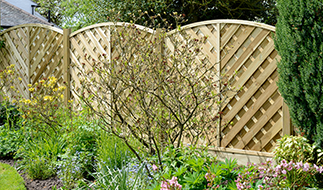Residential Gates
- Gates
- Railings
- Fencing
- Accessories
& Fitting- Sheds
& Storage- Garden Structures
- Design
& StyleMetal Gates & Railings- Info
& HelpResidential Gate and Fence Security
Often acting as your properties first line of defence the garden should never be overlooked when thinking about home security. This is because having a good level of protection to the boundary of your property can significantly help to deter burglars, criminals and trespassers. It is therefore essential that any gates or fencing you may have are well maintained and kept locked whenever possible in order that they act as an effective security deterrent.
Furthermore, if you live in an area of high crime, suffer from fly tippers or have issues with unauthorised access to the rear of the property (such as through a shared alley way) it is advisable to speak with neighbours about installing a high security gate with an integral lock as this will act as a great additional security measure.
Rear Fencing – What you need to Know!
Whenever possible fencing panels should be around 1.8m in height. Although planning permission is not normally required for a fence up to this height it is recommended you make the relevant checks prior to commencing any works.
Fence panels should be installed as close to ground level as possible so that they prevent anyone climbing underneath. Where the ground slopes or is uneven it may be necessary to step the fencing or increase and decrease the height accordingly.
Horizontal bracing that is common to most types of residential fencing systems should be kept to the inside of the property and can be chamfered by 45 degrees as this makes it more difficult to gain a foothold or climbing aid.
Where slotted posts have been used it is important that fence panels cannot be lifted up and out. As such make sure they are held in place using a fixing appropriate to the type of post material.
Ensure that fencing is kept in a good state or repair. A neglected fence may have become weakened over time through exposure to the elements and as such sends a signal that the rest of the home may also be neglected or have a lower level of security in place.
Garden & Boundary Walls
Although it may be cheaper to install a fence on top of an existing wall rather than to have it built higher in brickwork, it is important that any fence or trellis is installed flush with the outside face of the brickwork as this will prevent anyone trying to scale it from gaining a foothold.
It is not recommended to use metal fence panels to increase the height of a low rear boundary wall. This is down to the open design offering hand and footholds which make it far easier to climb over than a simple yet effective closeboard fence panel.
Adding Height to Existing Fencing
The addition of trellis with a diamond design makes a great addition for any timber fence. This is because the shape of the trellis makes it difficult to gain hand and footholds therefore making it more difficult to scale. This option can also be further enhanced with the addition of thorny shrubs and plants trained to intertwine the trellis.
Commercial type products such as anti-climb paint, spikes or razor wire are not recommended for residential use.
Fencing for the Front of your Home
A low 3ft high fence around the front of the home provides a clearly marked boundary to your property and as such makes it better protected against trespassers. It can also make it more difficult for a person to claim they did not realise they had entered onto the land unlawfully.
If your home does not currently have a fence or other defined boundary and you would like to add one we recommend you speak to the local planning department prior to completing any works or committing to expensive purchases.
We also recommend that the front fence (wall, hedge or other similar means of defence) should not exceed a height of approximately 1m. This is because it will reduce visibility from the street (giving criminals a place to hide) and in some cases may actually prove to be counterproductive.
Gates for the Garden or Driveway
Wherever possible it is advisable that any rear garden gates are the same height as the fence they are installed between. This is normally in the region of 1.8m (6ft) but will vary according to property type and location. Where existing gates do not meet this criteria it may be possible to increase the height with the addition of trellis panels.
Homes that have access from the front garden directly through to the rear garden should have fence panels running along the side of the property at the same height as at the back of the property.
Pedestrian access points should have a gate installed at the same height as the fence and should be secured with a lock.
Metal gates offer lower levels of privacy however due to the open design do not offer the criminal an opportunity to conceal themselves from view. In comparison a solid wooden side gate will offer lots of privacy but may actually offer a lower level of security.
Try to pick a design that offers little in the way of footholds. Gate designs with simple vertical bars and fleur de lys finials such as our Saxon, Corfe, Hampton, Balmoral and Royal Talisman designs are good examples of the kind of design to look for.
Gate Fittings and Locks
Whatever style of gate you may currently have or may choose in the future we recommended you follow these 5 steps to make sure they remain secure.
- Timber gates should always have the hinges fitted on the back of the gate as this prevents them from being easily tampered with.
- Metal gates should be installed with the top hinge pin reversed (so it points down) as this will prevent it from being lifted off the post.
- Wherever possible always keep gates locked whenever access is not required. In the case of metal gates the use of a quality padlock is normally adequate however for more regular access a lock can be integrated into the gate design itself during the manufacturing process.
- Where a pair of gates need to be locked together we recommend the use of a lockable drop bolt as well.
- Make sure gates are well installed, have secure fixing points and are in a good state or repair.
- Railings



